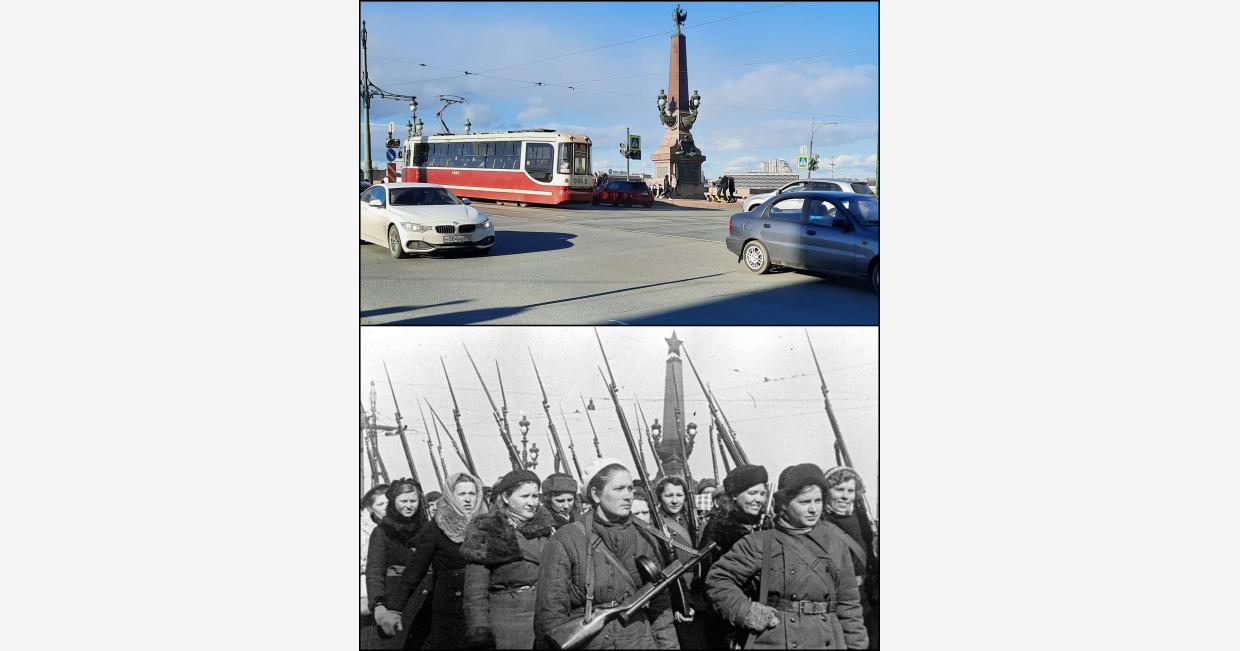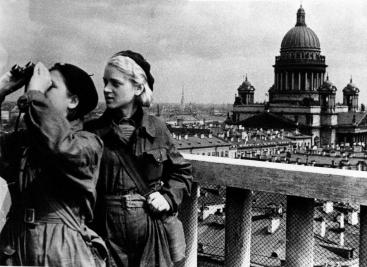Kirovsky bridge, Leningrad. 1942 / Troitsky bridge, St. Petersburg. April 2021
A battallion of MPVO girls marching across the bridge.
From the article "Female soldiers in Leningrad MPVO units". Muradova Gulnara Yakubovna, Master of History, Leningrad State Pushkin University // Leningrad State Pushkin University Journal, 2010:
"The Local Anti-Aircraft Defense (MPVO) was an important part of the general AA defense of the city, intended for clearing the debris from artillery shelling and air bombing. The MPVO of Leningrad was made up of 85%-90% female personnel. The service in this branch of armed forces was no less dangerous and difficult than in combat formations and required the mobilisation of all physical and mental effort from girls and women for saving their native city. This was a serious challenge for most of them, and many female MPVO soldiers noted in their reports and memoirs how scared they were of serving their guard duty on top of MPVO towers. Overcoming their fear, they got used to this as the time passed and stopped being afraid at all.
Here is, for example, what A.S. Semyonova, who served in the Leninsky district MPVO unit, wrote about it: "My job was to stay on guard duty on a tower which was located on top of the house #29 on Izmailovsky prospekt. I had to observe all the bombings. It was scary at first, but then I got used to it". A similar account was provided by L.P. Mikhailova, observer of the 330th MPVO Battalion who stayed on guard duty on the rooftop of house #128 on Obvodny canal: "On November 4, 1943 I was in my observation tower together with my assistant. An artillery shelling started. I could see the telephonist become very scared. She stood there, shaking all over. Shell fell all around us, and she just stood and couldn't move a finger out of fear. I had to conduct the observation alone by myself. The girl got used to it later. She sometimes stayed on the tower alone and didn't tremble".
Similar passages can often be found the memoirs of girls who served in the MPVO and other branches of armed forces which defended Leningrad. Having analysed them, I believe it would be fair to conclude that the women adapted psychologically to the terrifying realities of wartime. This conclusion is supported by the fact that the girls often found "wondrous moments" even in bombings and shellings. "It was scary to stand there, but very beautiful too, when incendiary bombs fell or when these lighting flare "lamps" came down", "Everything is highlighted around, fires can be seen. It's both beautiful and scary. A terrifying kind of beauty it was".
The following episode, reported by A.A. Andreyeva from an MPVO unit of the Dzerzhinsky district, can be presented as an example of an MPVO soldier's heroic act: "...Sergeyeva was standing on the tower. An artillery shell hit the building the tower was built upon. Sergeyeva was peppered with shrapnel all over. She was wounded and bled profusely, but she kept standing at her post until the next shift arrived and relieved her of duty". She spent a whole month in hospital recovering from her injuries.
Another of the numerous examples of the girls' self-sacrifice was also recorded in the memoirs of A.A. Andreyeva:
"In 1943 I was on my guard duty on Ogorodnikov prospekt, 11/3. At 10am an artillery shelling started. Shells kept falling in our area. Shells kept exploding incessantly here and there... I kept standing and reported the explosions and damages to the HQ. Then all around me suddenly went dark, my ears started ringing, I could neither see nor hear. I couldn't understand what was going on but stayed at my combat post".
After the HQ lost contact with the female soldier, other MPVO girls were dispatched to the tower and found her unconscious. When A.A. Andreyeva came to her senses at the hospital she learned she had sustained an artillery concussion.
The guard duty on top of MPVO towers was held round the clock. At the start of the siege there were 2 girls at each guard post, but later, due to personnel losses, there was just one girl per observation tower."

